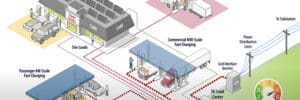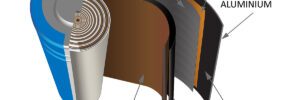
Researchers at the DOE’s National Renewable Energy Laboratory (NREL) are working to help scale up the charging infrastructure that will be needed to power the tens of thousands of commercial EVs expected to hit the roads in coming years. (In 2024, American companies deployed more than 15,000 medium- and heavy-duty EVs.)
A recent article explains why the new Megawatt Charging System (MCS) standard, which supports charging rates of up to 3.75 MW, will be a key piece of the new charging ecosystem. The article also details several initiatives NREL is pursuing to help develop the next generation of heavy-duty EV charging infrastructure, and is well worth reading in its entirety.
Medium-duty EVs can charge overnight or during breaks in service using Level 2 or CCS chargers, but heavy-duty trucks are a different story. Charging a Class 8 semi at 350 kW (the highest power generally available for passenger EVs) would take several hours.
“The MCS can provide so much more power than existing light-duty chargers that, rather than taking hours using a light-duty charger, commercial vehicle charge sessions can be completed in 30 minutes or less,” said Isaac Tolbert, an NREL EV charging researcher. “The MCS really expands the capabilities and potential uses of commercial EVs for vehicle operators that need to get back on the road faster.”
NREL has built a high-power EV charging emulation and evaluation facility. Through evaluation events hosted at NREL’s facilities, researchers ensure that high-power EV charging connectors from major manufacturers can provide up to 3.75 MW of electricity, can plug into commercially available EVs, and will not pose overheating or shock risks, even when misused. NREL researchers provide electric truck and charger manufacturers with detailed technical files to troubleshoot their equipment, allowing them to produce increasingly higher-quality technology.
The final MCS standard is now pending, and NREL researchers have turned their attention to designing the experimental, interoperable charging facility of the future.
The eCHIP project aims to create a high-power charging system that distributes DC power directly from electrical sources to EVs, with no need for conversion to/from AC to DC. The charging system envisioned by eCHIP researchers will allow for seamless integration of on-site energy production from solar panels and/or battery storage.
The laboratory has spent decades building FleetDNA, DOE’s largest body of real-world, in-use, high-resolution commercial vehicle data, along with a set of research tools that can provide the exact energy requirements for specific truck, bus and delivery vans to complete their routes.
The laboratory’s Heavy-Duty Electric Vehicle Integration and Implementation Tool (HEVII), along with the EVI-X EV charging infrastructure modeling suite, enables researchers to design and optimize EV charging stations tailored to the needs of commercial fleets.
Through these projects and many others, NREL is leading efforts to advance high-power charging, smart charge management, and global charging codes and standards—lowering the barriers to commercial charging, one by one.
Here’s hoping that NREL’s important work will be allowed to continue.
Source: National Renewable Energy Laboratory
from Charged EVs https://ift.tt/asxmltj

No comments:
Post a Comment